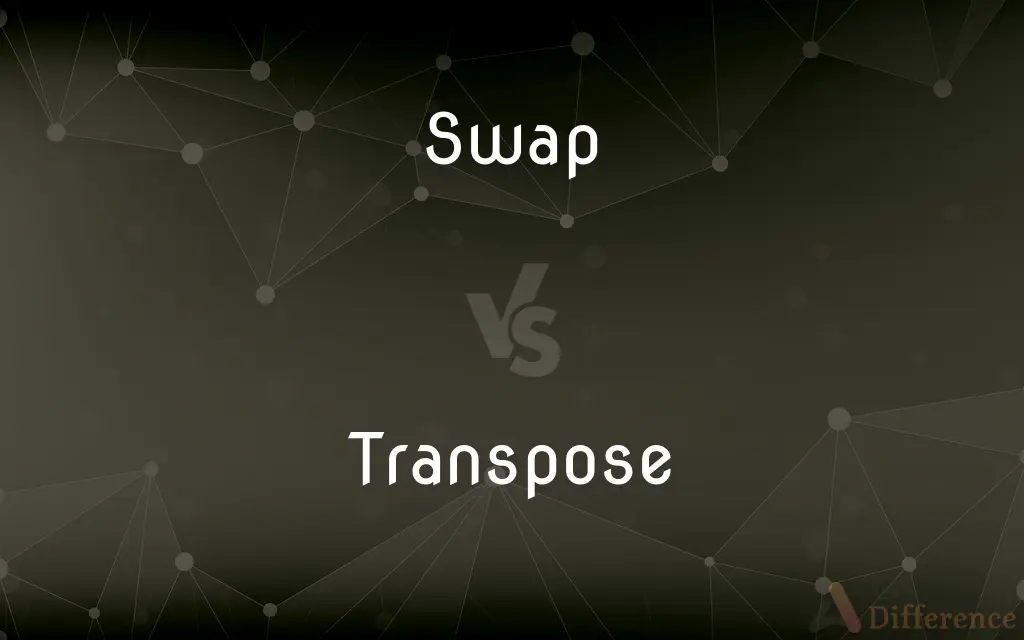Swap vs. Transpose — What's the Difference?
Edited by Tayyaba Rehman — By Maham Liaqat — Updated on April 9, 2024
Swapping refers to exchanging the positions of two elements, while transposing involves rearranging a matrix's rows and columns.

Difference Between Swap and Transpose
Table of Contents
ADVERTISEMENT
Key Differences
Swapping is a fundamental operation in programming and mathematics, where two elements exchange their positions within an array or variable context. This process is crucial in sorting algorithms and data manipulation tasks. On the other hand, transposing is a specific operation applied to matrices, where the matrix's rows become its columns and vice versa. This operation is key in linear algebra and in the manipulation of multidimensional data arrays.
In the context of programming, swapping often involves using a temporary variable to hold one element's value while it exchanges places with another. This concept is applied in various data structures and algorithms to rearrange elements to achieve a desired order or structure. Conversely, transposing a matrix in programming requires reorienting the entire data structure, which can be represented as a two-dimensional array, so that each row becomes a column and each column becomes a row. This operation is essential in numerical analysis and for certain types of data transformation in software development.
The swap operation can be seen in simple scenarios, like reversing the order of items in a list, or in complex algorithms, such as the quicksort algorithm, where choosing a pivot and then swapping elements based on their comparison with this pivot is fundamental to the algorithm's execution. Meanwhile, transposing is often utilized in mathematical contexts to change the orientation of a matrix, which is crucial for solving linear equations, transforming coordinates, and performing various matrix operations in physics and engineering.
Regarding complexity, swapping two elements is generally considered a simple and fast operation, typically executed in constant time (O(1)) since it involves a direct exchange of values between two locations. Transposing a matrix, however, can be more computationally intensive, especially for large matrices, as it requires repositioning each element in the matrix according to its transpose rules. The complexity of transposing can vary depending on the implementation but often involves nested loops to iterate through rows and columns, making it an O(n^2) operation for a square matrix of size n.
In terms of practical applications, swapping is widely used in day-to-day programming tasks, from simple value exchanges to complex data structure manipulations. It's a basic yet powerful technique for reordering, sorting, and organizing data. Transposing, while more specific in its application, plays a crucial role in mathematical computations, signal processing, image processing, and in the analysis of data where the relationships between different dimensions of data need to be reinterpreted or analyzed from a different perspective.
ADVERTISEMENT
Comparison Chart
Definition
Exchanging the positions of two elements
Rearranging a matrix's rows to columns and vice versa
Applied To
Individual elements, arrays
Matrices
Operation Type
Element-level operation
Structure-level operation
Complexity
Generally O(1) (constant time)
Depends on size, but often O(n^2) for a square matrix
Primary Use
Data manipulation, sorting algorithms
Mathematical computations, data transformation
Compare with Definitions
Swap
Element Exchange.
To correct the order, the two numbers were swapped.
Transpose
Computationally Intensive.
Transposing large matrices requires significant computational resources.
Swap
Used in Sorting Algorithms.
The bubble sort algorithm repeatedly swaps adjacent elements if they are in the wrong order.
Transpose
Used in Mathematical Computations.
Matrix transposition is crucial in solving linear equations.
Swap
Versatile Application.
Swapping is used in various programming contexts, from array manipulation to algorithm optimization.
Transpose
Matrix Rearrangement.
Transposing the matrix flipped its rows and columns.
Swap
Requires Temporary Storage.
Swapping two variables often requires a temporary variable to hold one of the values.
Transpose
No Temporary Storage Needed.
Transposing a matrix in place can be done without additional memory for square matrices.
Swap
Simple Operation.
A swap operation is simple and executed in constant time.
Transpose
Specific Application.
Transpose operations are specific to matrix and multidimensional data manipulation.
Swap
Take part in an exchange of
We swapped phone numbers
I'd swap places with you any day
I was wondering if you'd like to swap with me
Transpose
In linear algebra, the transpose of a matrix is an operator which flips a matrix over its diagonal; that is, it switches the row and column indices of the matrix A by producing another matrix, often denoted by AT (among other notations).The transpose of a matrix was introduced in 1858 by the British mathematician Arthur Cayley.
Swap
An act of exchanging one thing for another
Let's do a swap
Transpose
To reverse or transfer the order or place of; interchange.
Swap
To trade one thing for another.
Transpose
(Mathematics) To move (a term) from one side of an algebraic equation to the other side, reversing its sign to maintain equality.
Swap
To exchange (one thing) for another.
Transpose
(Music) To write or perform (a composition) in a key other than the original or given key.
Swap
An exchange of one thing for another.
Transpose
To render into another language.
Swap
A contract in which two parties agree to exchange periodic interest payments, especially when one payment is at a fixed rate and the other varies according to the performance of a reference rate, such as the prime rate.
Transpose
To alter in form or nature; transform
A diary that was transposed into a novel.
Swap
(transitive) To exchange or give (something) in an exchange (for something else).
Transpose
(Music) To write or perform music in a different key.
Swap
To hit, to strike.
Transpose
To admit of being transposed.
Swap
To beat the air, or ply the wings, with a sweeping motion or noise; to flap.
Transpose
A matrix formed by interchanging the rows and columns of a given matrix.
Swap
To descend or fall; to rush hastily or violently.
Transpose
(transitive) To reverse or change the order of (two or more things); to swap or interchange.
Swap
An exchange of two comparable things.
Transpose
To rewrite or perform (a piece) in another key.
Swap
(finance) A financial derivative in which two parties agree to exchange one stream of cashflow against another stream.
Transpose
To move (a term) from one side of an algebraic equation to the other, reversing the sign of the term.
Swap
Space available in a swap file for use as auxiliary memory.
How much swap do you need?
Transpose
To rearrange elements in a matrix, by interchanging their respective row and column positional indicators.
Swap
(Cantab slang) A social meal at a restaurant between two university societies, usually involving drinking and banter; commonly associated with fining and pennying; equivalent to a crewdate at Oxford University.
Transpose
To give force to a directive by passing appropriate implementation measures.
Swap
A blow; a stroke.
Transpose
To reach a position that may also be obtained from a different move order.
Swap
To strike; - with off.
Transpose
A matrix with the characteristic of having been transposed from a given matrix.
Swap
To exchange (usually two things of the same kind); to swop.
Transpose
The resulting matrix, derived from performing a transpose operation on a given matrix.
Swap
To fall or descend; to rush hastily or violently.
All suddenly she swapt adown to ground.
Transpose
(linear algebra) The process of rearranging elements in a matrix, by interchanging their respective row and column positional indicators.
Swap
To beat the air, or ply the wings, with a sweeping motion or noise; to flap.
Transpose
To change the place or order of; to substitute one for the other of; to exchange, in respect of position; as, to transpose letters, words, or propositions.
Swap
A blow; a stroke.
Transpose
To change; to transform; to invert.
Things base and vile, holding no quantity,Love can transpose to form and dignity.
Swap
An exchange; a barter.
Transpose
To bring, as any term of an equation, from one side over to the other, without destroying the equation; thus, if a + b = c, and we make a = c - b, then b is said to be transposed.
Swap
Hastily.
Transpose
To change the natural order of, as words.
Swap
An equal exchange;
We had no money so we had to live by barter
Transpose
To change the key of.
Swap
Exchange or give (something) in exchange for
Transpose
A matrix formed by interchanging the rows and columns of a given matrix
Swap
Move (a piece of a program) into memory, in computer science
Transpose
Change the order or arrangement of;
Dyslexics often transpose letters in a word
Transpose
Transfer from one place or period to another;
The ancient Greek story was transplanted into Modern America
Transpose
Cause to change places;
Interchange this screw for one of a smaller size
Transpose
Transfer a quantity from one side of an equation to the other side reversing its sign, in order to maintain equality
Transpose
Put (a piece of music) into another key
Transpose
Transpose and remain equal in value;
These operators commute with each other
Transpose
Change key;
Can you transpose this fugue into G major?
Common Curiosities
What is matrix transposition?
Matrix transposition is the operation of flipping a matrix over its diagonal, exchanging its rows and columns.
Can swapping be done without a temporary variable?
Yes, swapping can be done without a temporary variable using arithmetic or bitwise XOR operations, though these methods have limitations.
Is swapping used in all sorting algorithms?
Not all, but many sorting algorithms use swapping to reorder elements into a sorted sequence.
Why is transposing important in linear algebra?
Transposing is crucial in linear algebra for operations like finding matrix inverses, solving linear systems, and performing eigenvalue analyses.
Is transposing applicable to non-square matrices?
Yes, transposing can be applied to any matrix, resulting in a change of its dimensions from m×n to n×m.
What is the difference between swapping and sorting?
Swapping is an operation that exchanges two elements' positions, while sorting is a process that organizes elements into a specified order, often using swaps.
Can you transpose a vector?
Yes, a vector can be transposed from a row vector to a column vector or vice versa.
What computational resources are needed for transposing large matrices?
Transposing large matrices may require significant memory and processing power, especially for non-square matrices.
What does it mean to swap elements?
Swapping elements means exchanging their positions within a data structure.
Can transposing a matrix change its determinant?
No, the determinant of a matrix remains the same after transposition.
What's the benefit of swapping in programming?
Swapping allows for efficient element reordering and manipulation in various programming and algorithmic contexts.
Does swapping affect the original array?
Yes, swapping directly modifies the positions of elements within the original array.
How does transposing affect a matrix's properties?
Transposing can change a matrix's properties, such as turning row vectors into column vectors and affecting matrix multiplication operations.
How is swapping different from exchanging?
Swapping is a form of exchanging specific to the positions of two elements, often used in a precise programming or mathematical context.
Are there algorithms that transpose matrices efficiently?
Yes, various algorithms are designed to transpose matrices efficiently, especially for sparse or large matrices.
Share Your Discovery

Previous Comparison
Afraid vs. Petrified
Next Comparison
Franchise vs. OutletAuthor Spotlight
Written by
Maham LiaqatEdited by
Tayyaba RehmanTayyaba Rehman is a distinguished writer, currently serving as a primary contributor to askdifference.com. As a researcher in semantics and etymology, Tayyaba's passion for the complexity of languages and their distinctions has found a perfect home on the platform. Tayyaba delves into the intricacies of language, distinguishing between commonly confused words and phrases, thereby providing clarity for readers worldwide.















































